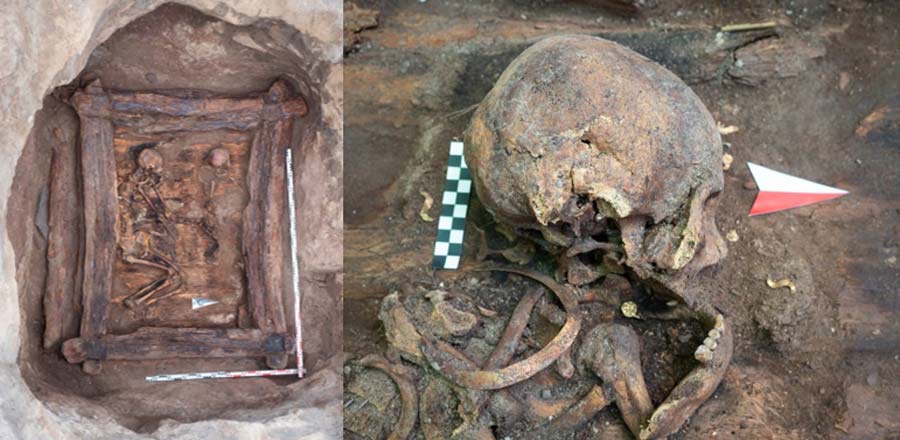Unique Golden Pectoral Ornament Found in 2,500-Year-Old Scythian Grave
While performing excavations inside a large barrow (burial mound) at a place known as the “Siberian Valley of the Kings,” a team of Polish and Russian archaeologists uncovered the remains of two Scythian bodies, who were likely buried there around 500 BC. One was that of a toddler, and the other was of a middle-aged woman. Next to the woman they found a rich collection of Scythian burial goods, including golden ornaments, an iron knife, a bronze mirror, and an engraved wooden comb.
One of these items especially intrigued the archaeologists.
“A particularly interesting artifact was a golden pectoral ornament, a decoration hung at the neck in the shape of a sickle or crescent,” Dr. Łukasz Oleszczak, an archaeologist from Jagiellonian University in Kraków and leader of the Polish half of the dig, said in a press release issued by the Science in Poland website.
Such Scythian burial goods have been found before in Siberian burial mounds, Dr Oleszczak acknowledged. But until now, they’ve been discovered exclusively in the graves of men.
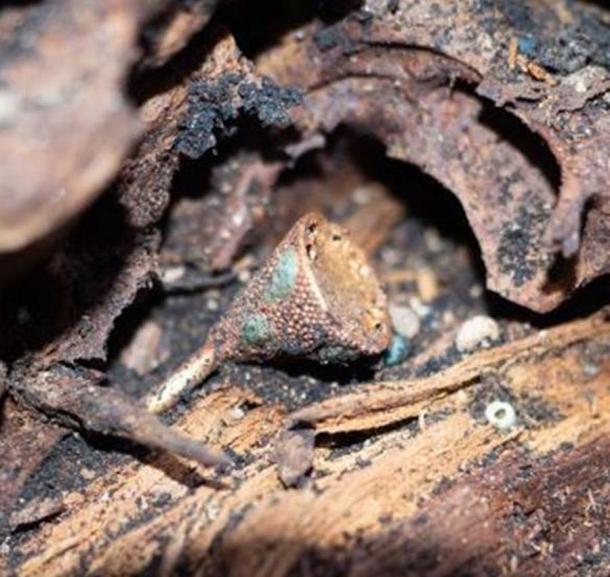
Next to the remains of the woman, the researchers found unique gold ornaments. (Igor Pieńkos / Science in Poland)
Siberian Scythian Site Continues To Amaze!
The Scythian archaeological site popularly known as the Siberian Valley of the Kings is actually called Chinge-Tey. It is located in the Touran-Uyuk valley in the republic of Tuva, in the southern part of Siberia. This valley features an impressive collection of first millennium BC burial mounds, some of which are referred to as princely barrows because of the political ranking and influence of the individuals interred inside them.
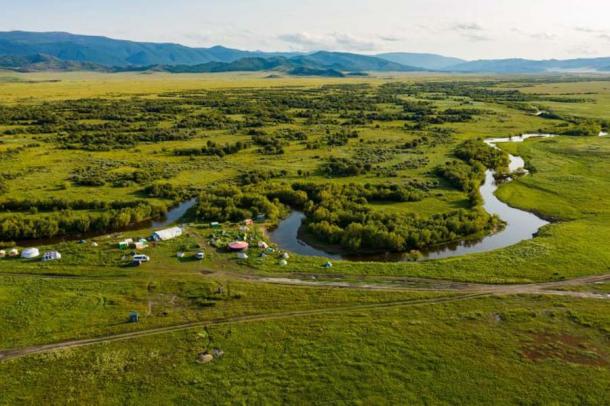
The archaeological camp on the bank of the river Uyuk River in Tuva, Russia, where the latest Scythian finds were made. (Igor Pieńkos / Science in Poland)
At the time when the woman and child lived, the lands of southern Siberia were occupied by the legendary Scythians. This nomadic warrior people ruled the region by skill, determination, and force, creating a nomadic empire that lasted for five centuries.
- High Levels Of Ancient Extreme Siberian Nomadic Violence Discovered
- Eye-conic Siberian Spectacles: Dazzling Eye Fashion From 2,000 Years Ago Until Today
The Scythians were deeply committed to spiritual practices, and the Touran-Uyuk valley was one of their most important ceremonial and ritual centers. The large burial mounds they left behind, plus the expansive quantities of elaborate burial goods those mounds often contained, reveals just how serious they were about honoring their departed leaders and loved ones.

The high-ranking Scythian woman and child in their barrow grave and the pectoral crescent or sickle shaped neck ornament is clearly visible beneath the woman’s skull. (Igor Pieńkos / Science in Poland)
A Woman of Importance in a Warrior Culture
The graves of the woman and child were first uncovered by Jagiellonian University archaeologists in 2021. The researchers estimate that the woman was about 50 years old at the time of her death, while the child would have been no more than three. Their skeletons were unearthed from a badly damaged and almost completely flattened barrow tomb, which was impossible to detect without aerial laser technology even though it was approximately 80 feet (25 meters) in diameter.
Fortunately, the damage to the outer part of the barrow didn’t impact the tomb it encased. The burial chamber was constructed from thick wooden beams and covered with three layers of beams on the top for superior reinforcement. As a result, the skeletons were well protected, along with the unique burial goods that were housed in the tomb with them.
The golden pectoral ornament, which is distinctly crescent, or sickle shaped, found next to the woman was a definite sign of her exalted status. Just exactly what her status was, however, remains undetermined.
“They [the golden ornaments] were considered symbols of belonging to a social group, caste, perhaps warriors—in any case, men,” Dr. Oleszczak explained. “Its presence it in the grave of a woman is a very interesting deviation from this custom. This certainly confirms the unique role of the deceased in the community of the Valley of the Kings.”
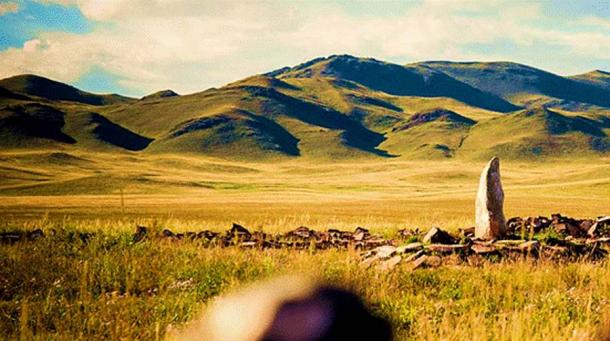
The landscape around the first Arzhan kurgan in the Tuva Republic, southern Siberia, Russia. (Zamunu45 / CC BY-SA 4.0)
The burial tomb that held her 2,500-year-old skeleton was located right next to the barrow of a prince. The archaeologists believe the woman would have been a part of his royal entourage, as were the other people buried inside her barrow.
The Polish and Russian archaeologists know there were multiple people interred in the barrow, because they found two other graves there during excavations that took place in 2019.
One of these graves had unfortunately been cleaned out by robbers. But the second held the skeleton of a heavily-equipped young adult warrior, whose collection of burial goods included several different types of weapons and a cache of golden ornaments. The tomb that contained this individual was one of 10 tombs that were aligned in a straight north-south line, cutting across the western section of the larger burial complex.
In addition to the tomb of the woman and the child, the archaeologists actually found one more grave during the most recent excavation season. They uncovered this burial site just outside the ditch that encircled the barrow. Inside they discovered the skeletal remains of an adolescent, who had been buried in a small pit surrounded with stones. There were no burial goods found in this particular grave.
“Graves of children on the perimeter or just outside the ditch surrounding the barrow are a typical part of the funeral rites of this early Scythian culture,” Dr. Oleszczak confirmed.
While exploring the perimeter of the barrow with a metal detector, the archaeologists found more intriguing evidence of ancient human activity. After getting strong hits on the detector, they dug down and found several well-preserved bronze artifacts. Their discoveries included a bronze ice axe, a goat-shaped ornament, and dozens of horse tack parts. During previous excavations in the area, the Polish and Russian archaeologists had discovered arrow shafts, an ice axe handle, and a piece of a quiver (a pouch used to hold arrows).
Most of what has been found at Chinge-Tey was clearly left behind by a warlike culture that celebrated martial values, which is consistent with what historians and archaeologists know about the Scythian people.
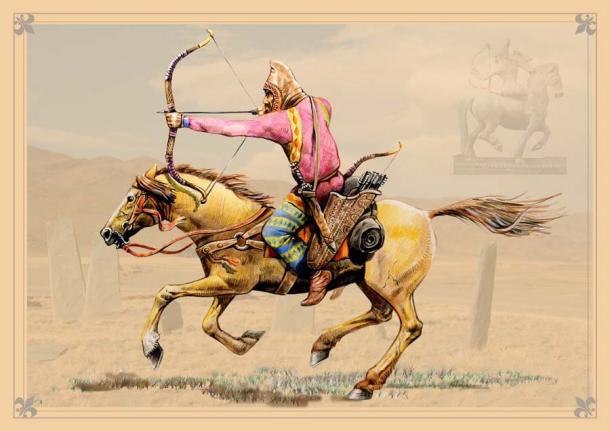
A Scythian mounted archer from a historical illustration. (Lunstream / Adobe Stock)
In Search of the Fierce Scythians, the Empire Builders of the Eurasian Steppes
The Scythians were an ancient nomadic group that controlled the lands of the Pontic Steppe, a vast area of open grassy plains that stretched northeast of the Black Sea into southern Russia, for approximately 400 years, from the seventh through the third centuries BC. The Pontic Steppe covered almost 400,000 square miles or nearly one million square kilometers of land area, and the ancient state of Scythia could be found within its borders.
Based on the known characteristics of their language, it is believed that the Scythians originally migrated to southern Russia from Iran. The Scythian culture was based around the glorification of warfare, and their armies were so powerful and well-organized that they dominated the lands and people of the Pontic Steppe with ease.
- Bronze Age Bull Geoglyph Found In Siberia Is A First
- Dancing Figurine from Ancient India Travelled Silk Road To Siberia!
The Scythians were one or the first nomadic peoples to master the art of mounted warfare, and it was this innovation that allowed them to form Central Asia’s first true nomadic empire. Appropriate for a culture that measured its worth through success in battle, the Scythians of the first millennium BC were led by an aristocracy of warriors known as the Royal Scythians. These individuals were recognized as the best of the best, in a culture that was always ready and willing to fight.
It seems likely that the individual buried in the princely barrow in Chinge-Tey was a member of this ruling aristocracy. The woman and the child recently unearthed nearby would have been associated with him somehow, possibly via family relations. In fact, it’s possible that all the gravesites found in the barrows of the Siberian Valley of the Kings were reserved for people that were either Royal Scythians or their closest relatives.
The Polish and Russian archaeologists involved in the ongoing Siberian excavations have no doubt that many more treasures are waiting to be discovered in the Touran-Uyuk valley. The Scythians were known for filling the graves of their most esteemed figures with abundant quantities of high-quality burial goods, and even in their more modest tombs (like that of the woman and small child) unique and impressive artifacts can usually be recovered.
Top image: The Scythian woman’s skull found in a new Siberian burrow tomb at the famous “Siberian Valley of the Kings,” and her large crescent shaped gold neck ornament clearly visible along with another gold item just below her upper jaw. Source: Igor Pieńkos / Science in Poland
By Nathan Falde


















